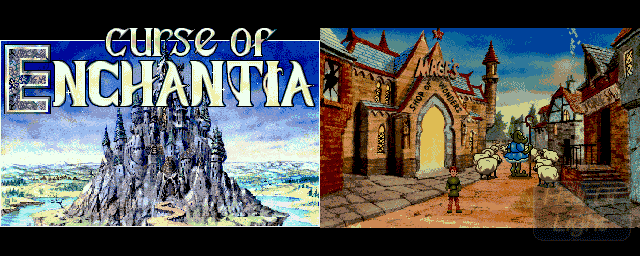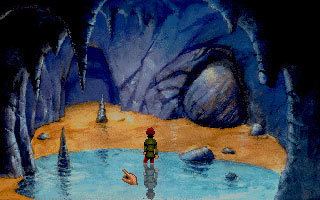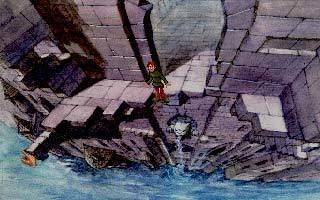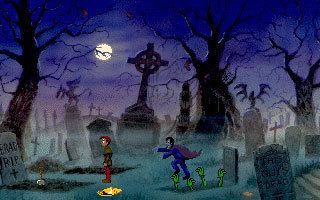7.4 /10 1 Votes7.4
3.6/5 Abandonware DOS Producer(s) Jeremy Heath-Smith Initial release date 1992 Genre Adventure game | 3.9/5 My Abandonware 3.5/5 GamesNostalgia Composer(s) Nuke (Martin Iveson) Mode Single-player video game | |||||||||||||||||||||||||||||||||
 | ||||||||||||||||||||||||||||||||||
Distributor(s) Sega/OziSoft (Australia)Proein (Spain) Designer(s) Robert TooneIan SabineChris Long Artist(s) Rolf MohrBilly AllisonStuart Atkinson Similar Core Design games, Adventure games | ||||||||||||||||||||||||||||||||||
Let s play curse of enchantia
Curse of Enchantia is a graphic adventure game developed and released by the British video game company Core Design for MS-DOS and the Amiga in 1992. The game tells the comic fantasy story of Brad, a teenage boy from modern Earth who was magically abducted to the world of Enchantia by an evil witch-queen. Brad needs to escape and take on the forces of darkness to find a way back to his own dimension.
Contents
- Let s play curse of enchantia
- Amiga longplay curse of enchantia
- Gameplay
- Plot
- Development
- Release
- Reception
- Legacy
- References

Curse of Enchantia was Core Design's first attempt in the adventure genre as they set up to compete with LucasArts and Sierra On-Line. The game features several highly unconventional and controversial game mechanics and design choices for an adventure title from that era, including having many simple action game style sequences and being practically devoid of in-game text and conversations.

Nevertheless, Curse was generally well received upon its release, especially by the Amiga magazines, where the game's graphics and animation received particular praise even as its illogical puzzles and unusual design choices were often criticized. A direct sequel was briefly planned but eventually turned into a spiritual successor game titled Universe and released in 1994.

Amiga longplay curse of enchantia
Gameplay

Curse of Enchantia uses a point and click style user interface, similar to Sierra's Creative Interpreter from the King's Quest series. The player character is commanded with an icon based control bar that is accessible by pressing the right mouse button, which also pauses the game. The control bar features seven main actions: inventory, pick up/take, manipulate/use (opening up a sub-menu with eight further actions: unlock, insert, push/pull, eat, wear, throw, give and combine), look, talk (only either "Help!" or "Hi!"), attack, and jump. Usually, the protagonist has to stand in the immediate vicinity to the game's objects and characters, which then appear as icons in a separate bar, in order to interact with them. A joystick or computer keyboard input can also be used.

The game does not feature text-based object descriptions or conversations, as its few short scenes of rudimentary communication with friendly non-player characters use only a minimalist system of pictograms in comic book-style speech balloons, usually displaying the objects that the characters need to be delivered. Instead, the game features several action-style sequences, such as dodging hazards or timing the use of items. However, the character is never at risk of dying, being effectively 'immortal' no matter the dangers, and thus every such task can be repeated until successfully completed, risking only losing a few points from the score. Jewels, gold coins, and other objects of value can be collected throughout the game for a higher score.
Plot

In a parallel universe, a fantasy world of Enchantia is suffering under the terrible rule of a powerful coven of wicked witches. Their queen, who managed to surpass the rest in her boundless cruelty and depravity, frantically seeks a live male child from another dimension as the main ingredient of her desired spell of eternal youth. Having borrowed magic powers from all the other witches in Enchantia on the promise to make them too young forever, she created an invisible portal connection to Earth. One day in our world in the 1990s, an American young teenager named Brad plays a baseball practice with his sister Jenny when the witch spots him through the portal and incants a summoning spell, making him suddenly vanish in a flash of light. The game begins as Brad, dressed in medieval-style clothing, wakes up in a dungeon cell. But the boy soon manages to escape, and then sets out on a journey to return home safely. In the course of his surreal adventure, he braves various dangers, meets a host of friendly and hostile characters, and rises to become a reluctant hero who just might break the titular curse and bring down the evil's reign.
After breaking out from his prison, Brad falls into a moat before coming to a halt in a maze of an underground cavern. Reaching the surface, he arrives at a nearby village; this location is repeatedly revisited throughout the game, as Brad comes back there after traveling to the various corners of the land, encountering bizarre characters and experiencing absurd adventures: the Edge of the World cliff, the Ice Palace, and the Valley of the Lost (a place where all kinds of things lost on Earth have gone to), all while searching for an unlikely set of items that would help him emerge victorious from the game's final showdown (including a fire extinguisher and an mechanical fan). In the end, the boy enters the evil Queen's castle to find and defeat her once and for all. Once she is no more, he gets instantly transported back to the baseball field where it all had started.
Development
Core Design's original concept for the game was to make it more like an action-adventure, before the project has evolved into a more classic adventure game. The game was supposed to be "an adventure for people who hadn't played that kind of game before." The protagonist's effective invincibility was a late demand by the executive producer Jeremy Heath-Smith, resulting in a series of minor plot changes. The game's co-designer and the Amiga version's chief programmer Rob Toone said that their idea was to make these parts of the game "interesting without being difficult." Co-designer and the PC version programmer Ian Sabine stated that the lack of text "speeds up gameplay". Regarding the decision to keep the onscreen text to a minimum, Toone said that "too much reading can slow the game or kill it, like The Adventures of Willy Beamish," with the main artist Rolf Mohr adding that "hopefully, a picture will say a thousand words and make this system easy to use." According to Toone, "Lucasfilm gets most of its humour out of its text, whereas we hopefully get ours from comical animations and daft happenings."
The both versions of the game, for the PC and the Amiga, were developed separately and simultaneously, in order to make the best possible product for each platform rather than a quick port from one system to another. A version for the Amiga CD32 had also been planned. The game mixes backgrounds hand-drawn with acrylic paint and then digitized by the Mohr, and sprite bitmap graphics made in Deluxe Paint and Brilliance on the Amiga with some rotoscoped animations. The animators Billy Allison and Stuart Atkinson created "huge" DPaint-made character sequences but they had to implement them in game in more efficient way due to computer memory limitations. In addition, the PC version used the full 8-bit color of a 256 color palette, but the Amiga version had to be downscaled to only 32 colors (including 24 colors for the background and eight colors for the main character; the other characters had to be drawn with these colors). The game also uses various digitized sound effects. Allison said, "there were whole sections that never made it in, like a roller skating frankenstein, that shattered into loads of tiny versions of him if you 'killed' him, I did the sprites etc, it just never made it to the game."
It took a month for the project to be completely storyboarded before any programming work started on it. While the game's design evolved over time, its original plot remained largely intact. Several revisions resulted in some of the already made some graphics and other content being cut from the game, in particular in the final area of the castle's interior (which at first was intended to be much longer and to feature monsters that would guard it, but in the end was reduced to a small area with the task basically limited to finding a secret chamber). The game's story and elements were partially inspired by The Lion, the Witch and the Wardrobe, The Wonderful Wizard of Oz , The Snow Queen, and Disney animated films, and relies heavily on surreal humor and slapstick. It contains several Easter egg pop culture references, including the shop called "Benn's Costume Shop" (complete with a costume of Batman), a band named "The Slugs" (consisting of four humanoid slugs), getting into a frozen realm through a wardrobe, and encountering the wreck of Marie [sic] Celeste. Curse of Enchantia was described by Stuart Campbell as "a funny version of Lure of the Temptress with a different plot." He was not the only one who noted the both games' similarities to each other. Its working title was initially Zeloria, which later caused some confusion as several video game magazines continued to use "Zeloria" as the name of the world in the game (some other magazines also incorrectly assumed Enchantia to be the name of the game's antagonist, who is actually unnamed). Some articles featured an earlier and slightly different version of the plot, which involved a castle of three witches, who needed to drink a special potion every hundred years or else they would turn to dust, and the protagonist Brad's original task involved a rescue of his captured sister Jenny.
Release
Curse of Enchantia was officially revealed under this title at the European Computer Trade Show (ECTS) in April 1992. The game was originally planned to be released in September 1992, but got delayed two months to November 1992. It was the first adventure game by Core Design as well as one of the first CD-ROM adventure games. Virgin Games bundled it with many of the earliest PC CD-ROM drives in 1993. It was also re-released on CD as part of Encore Multipack, together with Heimdall and Thunderhawk. The game's original release was accompanied by a promotional campaign with valuable prizes (computers and money) in some magazines such as France's Joystick. Owners of computers with newer PC operating systems need to run it using DOSBox.
Reception
Critical reception of Curse of Enchantia was mostly positive, especially in regard to its graphics and animation. However, the game was derided by some for its confusing user interface system, often illogical puzzle solutions and what some reviewers thought was a lack of quality humor, plot development and atmosphere, attributing it to the absence of text and dialogue.
British reviewers in particular have often praised the Amiga version of the game. Brian Sharp of Amiga Action gave this "well-made and cleverly constructed package" the Amiga Action Accolade award, calling it "flawless" and "easily the best adventure game on the Amiga to date." It hinted that using a joystick for control may make certain sections of the game "less annoying to play." Amiga Computing gave it the Gamer Gold award, calling the game "excellent", "down-right bloody enchanting" and Core Design's "easily greatest and most impressive game yet," and even advising to "buy it today because if you don't you will more than likely commit suicide, it's that good." Tony Gill of CU Amiga gave the game the CU Gold Screen award and said that while "some of the puzzles are a bit illogical, the further into the game you get the more luxurious it becomes. Around each bend the graphics get better and better." Les Ellis of Amiga Power said it was one of funniest games he has ever played and called it "a classic adventure, which with a few tweaks could have easily beaten the Monkey Island [series] and a worthy addition to any collection and will stand as a challenge to any adventurer." According to Amiga Power one year later, "with such a high degree of humour this adventure is well on its way to becoming a classic. It's slightly overpriced and some of the puzzles are a little obscure but these are minor quibbles. Overall this is a great game." Atari ST User even called it a "contender for the best game of the year."
There was also much positive reception in the gaming press elsewhere in the English world. The "absolutely enchanted" Ken Simpson from Australia's ACAR said the game's "delightful" graphics and animation "are among the most tastefully executed [he has] ever seen," but noted the problems with its interface system and difficulty. One preview in North American magazine Computer Gaming World called it "a pretty looking product" of "a Loom / KQV / Legend of Kyrandia approach," even as another called it "actually more of a multi-screen puzzle game than a traditional animated adventure," adding that "gamers with a strong penchant for puzzle should find it entertaining" despite its "a bit clumsy" interface. Bill Holder of Australia's OZ Amiga called it "a light-hearted and funny adventure that appeals to almost everyone" and "one of the better releases of 1993."
On the other hand, Ed Ricketts of Amiga Format called Curse of Enchantia "light years behind" Monkey Island with "no comparison" to Monkey Island 2, as "the textless interface just doesn't work - despite the designers' belief, you do need words" and there is "no humour to speak of, no genuinely amusing humour, anyway." Even as a preview in The One Amiga called it a "game set to rival even the mightiest of American adventures," the magazine's David Upchurch wrote that "the game lacks real humour and atmosphere. This may be partly due to the lack of text in the game - it's hard to relate to the characters you meet," and "although entertaining, Curse of Enchantia is to Monkey Island 2 what Smash is to mashed potato," that is "just a weaker substitute." Lee Perkins of The Age opined that "Curse of Enchantia might be seen as a mite disappointing by fantasy gamers with moderately sophisticated tastes." PC Gamer (UK) described it an "average generic fare" as "the graphics are pretty" but the game "lacks atmosphere and feels too much like a succession of annoyingly vague puzzles rather than an adventure story."
In France, Curse of Enchantia was given the high ratings of 84% in Génération 4 (PC) and 90% (Amiga) / 91% (PC) in Joystick. The game also received a score of 79% from Sweden's Datormagazin. Nevertheless, German magazine PC Player gave it only 38%, saying that the game may make the players "nostalgic for Sierra titles." It received better scores from other German magazines, including 53/60 in ASM, 79% in Amiga Joker, 81% in Power Play (DOS), 68% in both PC Joker and PC Games, and 70% (DOS) and 71% (Amiga) in Power Play. Italian magazines The Games Machine and K gave scores of 91% and 802/1000, respectively. Reception was also strong in Poland, where Curse of Enchantia was positively reviewed in C&A (95%) and Secret Service (77%), and featured among "the best adventure games" of 1992 (alongside Alone in the Dark, Indiana Jones IV and The Legend of Kyrandia) by Computer Studio. However, in a 1993 ranking of graphic adventures games by Spanish magazine PCmanía, Curse of Enchantia received only three stars out of six due to its "strange" design and despite Core Design's "trademark" good graphics. A 1996 retro review by France's PC Soluces gave it three stars out of five, stating that the game's interesting characters, surrealist feel and varied graphics were dragged down by "a bit weak" plot and an interface that was not intuitive enough.
Retrospectively, the website GamersHell found the lack of any text messages and dialogue in the game to be "an interesting design element." However, Gry-Online included the lack of even partial descriptions of objects among the reasons why Curse of Enchantia failed to become an outstanding game, along with a too many user interface icons and "useless" features. Wirtualna Polska ranked it as the 27th best Amiga game, but noted that "proponents of adventure genre's purity" to this day dislike the game for its "unwise flirt" with action-adventure, as well as the 19th best adventure game in history, opining that the lack of written text "perfectly" fits with the game's story and specific type of humor. It was also ranked as the 26th best Amiga game by Polish console gaming magazine PSX Extreme, noted for its strong playability. Curse of Enchantia was also the first Amiga video game owned by Ben "Yahtzee" Croshaw, who in 2012 made a Let's Play video of the PC version of the game, saying it had "great graphics, great animation, appalling game design.", and lamented much on the fact that the game contained "no kind of logic whatsoever" Yahtzee had earlier, in a 2005 interview, said, "it was a game I had difficulty putting down, with beautiful scenery and a great sense of humour, although I understand it's looked down upon by modern standards", something which he opposed in the 2012 Let's Play, then stating that the game lacked humour, and got a warning from co-comentator Gabriel Morten regarding Rose-tinted glasses. An advertisement for Curse of Enchantia was featured in GamesRadar's humor article about "what game ads looked like when the SNES was alive".
Legacy
A direct sequel for the game was briefly planned by Core Design. Few details were made available, but it would continue Brad's fight against the witches but his sister Jenny was considered to play a much larger role. However, it was never released (in part because of Robert Toone's departure from the company), as the new game "has grown up so much during the development that it has simply became a follow up." Its working title has still remained "Curse of Enchantia 2", but only "for practical reasons". This spiritual successor game ultimately became known as Universe. Released in 1994, the game uses an upgraded game engine of Curse of Enchantia and a similar user interface. Responding to some of the criticism of directed at Curse of Enchantia, Core Design described Universe as being "a lot" more logical and less linear than their first adventure game. They also described the text-based system as an improvement over the use of only icons, its benefits including allowing conversations between characters. They also acknowledged that Curse of Enchantia has "suffered considerably" due to inclusion of action sequences, something that "adventure gamers don't want in their games." The game's plot premise has remained similar to that of Curse of Enchantia, featuring a young man (the protagonist's name was changed from Brad to Boris, but he also has a sister named Jenny) who is transported to another world which has to save from an evil overlord. But Universe is more serious in its tone, as the game's humor only serves as comic relief and "it was never intended to be as silly as Enchantia."
Simon the Sorcerer, a 1994 adventure game similarly featuring a modern boy protagonist transported to a fantasy world where he has to vanquish an evil wizard, which was partially inspired by Curse of Enchantia, and a similar cover art was used for King's Quest VII. The game has also inspired the name of the Polish reggae band Enchantia, who chose this name because they thought it "feels warm". The game's chief artist Rolf Mohr said the cover art for Disney's 2007 film Enchanted could have been inspired by his cover art for Curse of Enchantia. He called it "a case of Art imitating Disney imitating Art," since he has been himself "definitely" inspired by Disney while working on the game. The "magical world of Enchantia" is the setting of the video game Enchantia: Wrath of the Phoenix Queen, but it does not appear to be otherwise related. Curse of Enchantia was also a "pretty big" influence on Yahtzee's own adventure games.
